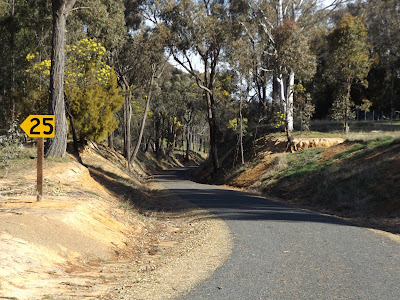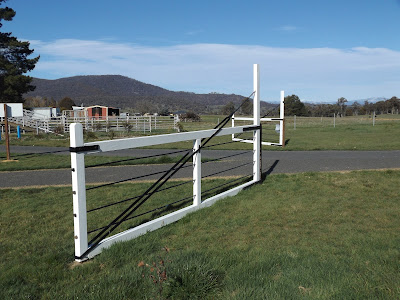Recycling
Rail
A comment
from Robert McKeown on my Blog post on the Docker street sidings, advised of a
new book on the Tumbarumba railway – “Recycling Rail” by Ron Frew. Robert said that it covered aspects of
railway stockyards, and timber mills in the Tumbarumba area.
The book
was available at the ARHS bookshops.
Well, a
check on-line showed that the book had been produced by the Tumbarumba
Historical Society, to coincide with the opening of the Rail Trail between
Rosewood, and Tumbarumba. Described by
the author
“as a social
history more than a traditional rail history of the Rosewood-Tumbarumba section
of the old line that served the local communities so well from 1921 until it
closed in 1974”
The rail
trail opened in April 2020. So I thought
I would head up to the mountains, and see for myself.
On the way
I detoured via Humula.
The visitor
center in Tumbarumba was open, and I secured the book. The Visitor center also had extremely nice
displays by the Historical society, including a sawmill model, and many
photographs that I have included in this blogpost. Many of these pictures also appear in the
book.
 |
| The Case mill was situated on a siding within the Tumbarumba Railway yard. This is the side that visitors to my layout will see. |
 |
| A water driven sawmill operated in the Tumbarumba area until 1915. The display in the visitor's center was a idealised representation. |
The book is
a softback, 154 pages, extensively illustrated.
The book is loosely arranged to cover the history of the Tumbarumba
area, the construction of the line, short biographies of “people of note”, a
chapter on the sawmills, gold mining, stock movements, and many quotes from
people who travelled and loved the railway.
There are also some details of the station masters at Tumbarumba, and
some railway incidents. The
final 40 pages deals with the conversion of the Rosewood to Tumbarumba section
to a rail trail, and the efforts in preserving much railway history.
The
photographs are worth the price of the book.
Some notable ones
-
the construction of the cuttings, and
embankments in the Downfall area, involving narrow gauge skips
-
The
Downfall navvy village
-
Timber
tramways
-
Sawmills
-
Gold
mining
-
Huts
-
Loading
wagons with timber
And my questions I asked on the Docker Street
sidings blog-post were also answered. I
know now that Hardys Wagga was just the retail/wholesale outlet for sawmills
owned by Hardys (and others) in the Tumbarumba areas, and they transported
timber by rail on a daily basis – up to 10 - 12 timber trains per week was
planned in the years prior to WWII. The Case mill, owned by Hardys, in the
Tumbarumba station precinct was a major user of the line, producing softwood
for fruit boxes, used in the Murrumbidgee Irrigation area out towards Griffith. The book says that the mill closed in 1962,
although it was still there in photographs after 1970. The nearby Hardys “Ribbon Mill” stayed
operational until 1971. A good enough
excuse to have the timber trains operational for my layout operation.
Some random images of the Tumbarumba end of the Rail Trail
 |
| The milepost peg close to its original location |
 |
| Downgrade out of the station |
 |
| Restored gates. These were restored by the local Mens Shed. |
The original Barracks building, after being recovered from a nearby farmer's field, and fully refurbished. It is not in its original location in the yard.
Important
as the physical aspects of a model railway are, having the background of why
certain things happened gives me a better appreciation of the operational
aspects. Thank you Ron for authoring
such a wonderful book, and thank you Robert for making me aware of its existence.
And, if you
happen to visit Tumbarumba, bring along your pushbikes, and ride the trail,
around 20km, then turn around and return.
The scenery is magnificent.

















You're welcome :) My family and I are coming down to Wagga Wagga in about 2 weeks for a farewell visit (we are moving to Western Australia before Christmas) and we are going up to Tumbarumba for a day trip. I love that photo of the mountains - beautiful!
ReplyDeleteSounds like it was an enjoyable field trip Rob. I'm guessing it will be a wintery mountain backdrop on your layout judging by that great picture!
ReplyDeleteIt was an enjoyable field trip, so much so, that I explored more of the line 2 weeks later, including the Downfall area in the forests. As for the time period - you could be right Phil. A distant view of snow has an appeal that is hard to ignore.
DeleteA new book on the line has just been published by the Ladysmith Tourist Railway & The Wagga Wagga Rail Heritage Association - "Wagga Wagga to Tumbarumba Railway - An Era of Change". I'll be picking up my copy at the ARHS Bookshop this week to complete my collection of all 4 books in the series :) The trip up to Tumbarumba was a bit of a downer due to the weather (rain and storms), but I did manage to see a bit of the old line as we drove along, so not a complete loss.
ReplyDeleteI had the luxury of being able to choose the time of my visit, but I am sorry that the weather was not good for your trip.
DeleteRe the book - I will have to acquire. As an aside, a larger book is planned to co-incide with the 100th anniversary of the line's opening to Tumbarumba next year.
Thanks for the heads up - moving to WA next week, so please let me know when it's out so I can order it online.
Delete